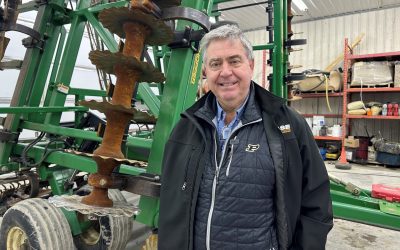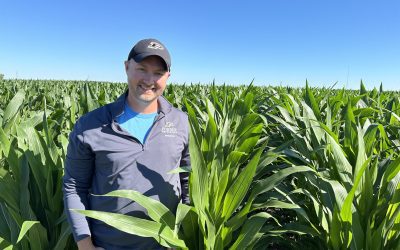Hoosier farmers pull together to turn ideas into conservation wisdom
Posted: November 3, 2022
Category:
ICMC, Indiana Corn and Soybean Post - Fall 2022, ISA
GREENCASTLE, Ind. — When government regulations for agriculture are on the horizon, farmers can resist or abide by the new rules. There are those who go so far as to turn compliance into leadership, though, with either their own best farm practices or knowing which neighbors to wisely emulate.
In 1985, Congress passed a farm bill with a conservation title that tied payments for price supports, farm storage, crop insurance, disaster reimbursement and more to requiring farmers to institute certain conservation practices if farming on highly erodible land. The bill included increased use of no-till.
Putnam County is comprised of many acres of highly erodible farmland. In 1987, Barry Fisher came to the local USDA Natural Resources Conservation Service (NRCS) office as district conservationist. Mark Legan, a Coatesville farmer and current board member and Market Development chair for the Indiana Soybean Alliance (ISA), was the county’s extension agent at that time. His wife, Phyllis, served on the Soil and Water Conservation District (SWCD) board.
“We’re a small crop farm,” Legan said, “but we try to do what we can to remain a part of (conservation efforts).”
This month, in fact, he hosted a lunch-and-learn on his farm for ISA and Indiana Corn Marketing Council (ICMC) members, focused on conservation and sustainability programs. At this event, Joe Rorick, who is ISA and ICMC’s On-Farm Sustainability Research and Project Coordinator, took a break from presentations to talk about how Fisher and Legan have been expanding conservation farming practices in Putnam County.
“What Mark and Barry and that group have done over these years – they just kind of all got together over breakfast,” he said of the informal roundtables Fisher helped start 35 years ago. “There need not be any big official thing; this can just be a group of friends or a group of people who are going to become friends, getting together to learn from each other.”
Neighborly leadership
“Putnam County has sort of always preached their own conservation for farmers, and Barry took that and ran with it,” Legan said. What Fisher did was facilitate roundtable discussions for local producers. “I was just a participant. I didn’t have anything to do with setting them up,” he explained.
“We put together a pretty targeted education and information campaign with all the ag agencies,” Fisher recalled, explaining the NRCS and other ag offices and groups decided to pool their expertise and resources rather than duplicating efforts. “We would have regular workshops and field days and things – but a big part of it was these roundtable networking meetings,” Fisher said.

In the beginning, organizers tried to arrange a meeting once a month in different parts of the county and bring in crop or extension specialists from Purdue University or other sources to talk or demonstrate on topics such as weed control, planter setup, starter fertilizer and more. The meetings included retail ag and equipment owners, who hosted some meetings at their stores and invited customers, as well as sponsoring speakers and refreshments. “If everybody’s sitting at the same table when the information is being shared or the education is being gained, it just makes success a lot easier,” Fisher said.
The meetings evolved into small networks of farmers, effectively crowdsourcing knowledge about what methods worked and what didn’t, he said. Some farmers would share on-farm inventions with others.
“When you decide you want something to work, that’s half the battle,” Fisher explained. “Then we figure out how to make it work.”

He described his role in this county conservation effort as mostly getting farmers together and letting their natural innovation take over with some directed help from ag specialists and research. One early example was trying to figure out how to manage manure application in a no-till environment. The group of farmers decided to work with a local contractor and swine producers on a way to apply injected hog manure in fields.
“A lot of (innovation) was equipment-related,” he said. “At almost every meeting, someone would come to the table with some new practice or product – for planting, weed control, water use or even a discovery on better burndown of cover crops.”
And it wasn’t just farmers being educated. Even when specialists gave presentations, he said, they usually picked up something new to take back to researchers and other specialists to show what was needed in real-world situations.
“The key to making this sort of thing work is for someone to take the lead on it,” Legan said, “and Barry took the lead on this” with his “passion to make it work.”
Reluctance to change
Fisher acknowledged anyone being forced to comply with new regulations may want to dig in their heels and not change. He said, “We keep doing what we survived doing last year, so there’s a natural instinct you’re working against” to make a change such as disrupting generations of tillage tradition.
“The bottom line is, we were solving a problem” – and farmers are more likely to adopt a practice if it solves a problem. Fisher said it’s also good to recognize those efforts publicly, such as the “Pride of Putnam County” awards and signs on farms that helped spread acceptance of new practices.
Legan noted local farming can be a competitive business, but when it comes to conservation and sustainability, buyers and end consumers want to know there are standards everyone is using. And if growers are willing to share knowledge with each other, they may find they can raise corn and soybeans less expensively while improving soil health. “It’s got to be good for the bottom line, too,” he said. Putnam County isn’t the only place where this sort of effort has worked, but it’s a good example of how to begin.
Fisher, who retired last year after 39 years with NRCS and whose last position was central region leader with its Soil Health Division, providing training and leadership for farmers and other ag stakeholders across several states, observed there are farmers who have created networks in other locations. They really benefit from having a local agency or group to assist, with office resources for meetings and contacts for lining up speakers and demonstrations.
Indiana has the Conservation Cropping Systems Initiative, which promotes scientific and farmer-proven soil health practices through grassroots leadership. Fisher said the CCSI helps with setting up meetings and networks, but relies on local leaders with the technical knowledge and contacts to know what education is needed and who will be those local shepherds.
These days, Legan said the educational meetings and demos don’t take place quite as frequently as they once did in Putnam County, but that’s because farmers have smaller networks and can communicate frequently without formal meetings. Fisher, who has a small farm there in addition to his consulting business, Fisher Soil Health LLC, said using cover crops now has almost become the new normal the same way no-till has evolved there.
A state of conservation
Two broader conservation efforts going on right now in Indiana are the Upper White River Watershed Cover Crop Program and INfield Advantage. Rorick is an agronomist with CCSI, whose office is at Purdue; last year, ISA and ICMC made an agreement with the university to use his expertise on soil health and ag conservation practices as their Soy/ Corn On-Farm Sustainability Programs and Research coordinator.

The Upper White River Watershed Cover Crop Program is regional, stretching north from Martinsville to Tipton, then east to Winchester, through at least part of 16 counties in central Indiana. Rorick said ISA and ICMC coordinate the aerial application of cover crop seed for farmers who participate. Researchers come to the farm for two soil fertility and basic cover biomass samples.
Then there’s INfield Advantage, which is a little more involved. Cover seed is delivered to a farm where the grower plants it themselves. Researchers collect more detailed data through soil tests, tissue samples and soil health assessments. Participants must first be eligible for the federal Environmental Quality Incentives Program (EQIP).
“Both programs are settled around (the type of thing) Mark and Barry have done for years, and we hear and we see that over and over in the social data as well, that farmers want to learn from other farmers,” said Rorick, adding ISA, ICMC and Purdue Extension are looking for other ways to foster more peer-to-peer networks around the state.

“There’s a lot of work out there on who farmers’ trusted advisors are, and at the top every time is other farmers.”
Again, these efforts are more about providing expert guidance to local networks of growers. Organizing “does not have to be a big, complicated thing with an agenda; it can just be a group of people gathered around a plate of biscuits for breakfast, or whatever.”
Farmers wanting a local network, who don’t know where to begin, can consult with their local Extension office, SWCD or NRCS for direction how to start with the Indiana Conservation Partnership’s help. Fisher’s advice for taking part in any sort of peer network is to keep an open mind in this sort of process and consider all points of view, even those with which you disagree.
“You can’t think, ‘That’s bad information,’” he explained, adding such data may still come in handy later.
Legan said it’s also good to get comfortable with the idea of sharing failures as well as successes, since both are instructive. “You’ve got to have a group that’s willing to share,” he said. “It’s give and take, not just taking.”



